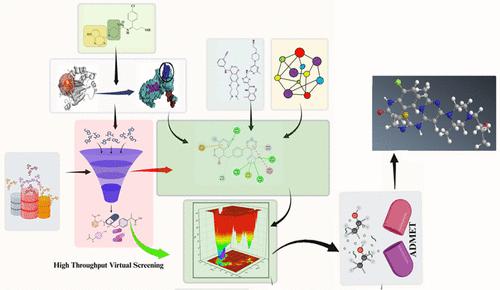当前位置:
X-MOL 学术
›
Mol. Pharmaceutics
›
论文详情
Our official English website, www.x-mol.net, welcomes your feedback! (Note: you will need to create a separate account there.)
Deciphering the Lexicon of Protein Targets: A Review on Multifaceted Drug Discovery in the Era of Artificial Intelligence
Molecular Pharmaceutics ( IF 4.9 ) Pub Date : 2024-03-11 , DOI: 10.1021/acs.molpharmaceut.3c01161 Suvendu Nandi 1 , Soumyadeep Bhaduri 2 , Debraj Das 2 , Priya Ghosh 1 , Mahitosh Mandal 1 , Pralay Mitra 3
Molecular Pharmaceutics ( IF 4.9 ) Pub Date : 2024-03-11 , DOI: 10.1021/acs.molpharmaceut.3c01161 Suvendu Nandi 1 , Soumyadeep Bhaduri 2 , Debraj Das 2 , Priya Ghosh 1 , Mahitosh Mandal 1 , Pralay Mitra 3
Affiliation

|
Understanding protein sequence and structure is essential for understanding protein–protein interactions (PPIs), which are essential for many biological processes and diseases. Targeting protein binding hot spots, which regulate signaling and growth, with rational drug design is promising. Rational drug design uses structural data and computational tools to study protein binding sites and protein interfaces to design inhibitors that can change these interactions, thereby potentially leading to therapeutic approaches. Artificial intelligence (AI), such as machine learning (ML) and deep learning (DL), has advanced drug discovery and design by providing computational resources and methods. Quantum chemistry is essential for drug reactivity, toxicology, drug screening, and quantitative structure–activity relationship (QSAR) properties. This review discusses the methodologies and challenges of identifying and characterizing hot spots and binding sites. It also explores the strategies and applications of artificial-intelligence-based rational drug design technologies that target proteins and protein–protein interaction (PPI) binding hot spots. It provides valuable insights for drug design with therapeutic implications. We have also demonstrated the pathological conditions of heat shock protein 27 (HSP27) and matrix metallopoproteinases (MMP2 and MMP9) and designed inhibitors of these proteins using the drug discovery paradigm in a case study on the discovery of drug molecules for cancer treatment. Additionally, the implications of benzothiazole derivatives for anticancer drug design and discovery are deliberated.
中文翻译:

破译蛋白质靶标词典:人工智能时代多方面药物发现综述
了解蛋白质序列和结构对于理解蛋白质-蛋白质相互作用 (PPI) 至关重要,而蛋白质相互作用对于许多生物过程和疾病至关重要。通过合理的药物设计来靶向调节信号传导和生长的蛋白质结合热点是有前途的。合理的药物设计使用结构数据和计算工具来研究蛋白质结合位点和蛋白质界面,以设计可以改变这些相互作用的抑制剂,从而可能导致治疗方法。机器学习 (ML) 和深度学习 (DL) 等人工智能 (AI) 通过提供计算资源和方法来推进药物发现和设计。量子化学对于药物反应性、毒理学、药物筛选和定量构效关系 (QSAR) 特性至关重要。这篇综述讨论了识别和表征热点和结合位点的方法和挑战。它还探讨了基于人工智能的针对蛋白质和蛋白质相互作用(PPI)结合热点的合理药物设计技术的策略和应用。它为具有治疗意义的药物设计提供了宝贵的见解。我们还展示了热休克蛋白 27 (HSP27) 和基质金属蛋白酶(MMP2 和 MMP9)的病理状况,并在癌症治疗药物分子发现的案例研究中使用药物发现范式设计了这些蛋白质的抑制剂。此外,还讨论了苯并噻唑衍生物对抗癌药物设计和发现的影响。
更新日期:2024-03-11
中文翻译:

破译蛋白质靶标词典:人工智能时代多方面药物发现综述
了解蛋白质序列和结构对于理解蛋白质-蛋白质相互作用 (PPI) 至关重要,而蛋白质相互作用对于许多生物过程和疾病至关重要。通过合理的药物设计来靶向调节信号传导和生长的蛋白质结合热点是有前途的。合理的药物设计使用结构数据和计算工具来研究蛋白质结合位点和蛋白质界面,以设计可以改变这些相互作用的抑制剂,从而可能导致治疗方法。机器学习 (ML) 和深度学习 (DL) 等人工智能 (AI) 通过提供计算资源和方法来推进药物发现和设计。量子化学对于药物反应性、毒理学、药物筛选和定量构效关系 (QSAR) 特性至关重要。这篇综述讨论了识别和表征热点和结合位点的方法和挑战。它还探讨了基于人工智能的针对蛋白质和蛋白质相互作用(PPI)结合热点的合理药物设计技术的策略和应用。它为具有治疗意义的药物设计提供了宝贵的见解。我们还展示了热休克蛋白 27 (HSP27) 和基质金属蛋白酶(MMP2 和 MMP9)的病理状况,并在癌症治疗药物分子发现的案例研究中使用药物发现范式设计了这些蛋白质的抑制剂。此外,还讨论了苯并噻唑衍生物对抗癌药物设计和发现的影响。



























 京公网安备 11010802027423号
京公网安备 11010802027423号